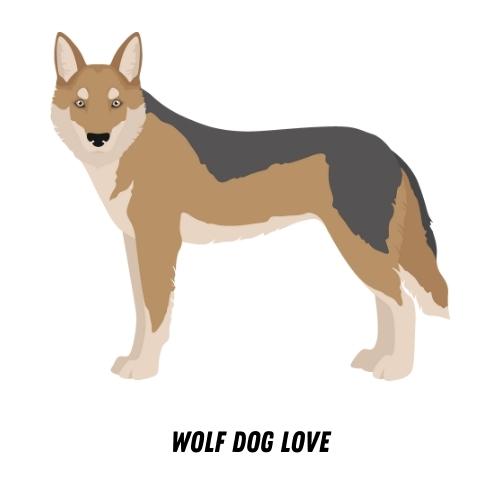Introduction: The Resilience of Wolf Dogs
Wolf dogs, a unique blend of domestic dog and wild wolf, are known for their remarkable resilience. This blog post will explore the concept of resilience in animals, particularly focusing on the wolf dog breed. We will delve into the traits that make these animals so resilient and how they overcome challenges. We will also look at some real-life examples of wolf dog resilience in action.
- Understanding the concept of resilience in animals
- Overview of the wolf dog breed
Resilience in animals refers to their ability to withstand or recover quickly from difficult conditions. It’s a measure of how well an animal can adapt to changes in its environment, whether that’s a change in weather, a lack of food, or the presence of predators. Resilience is a key survival trait in the animal kingdom, and wolf dogs are a prime example of this.
Wolf dogs are a hybrid breed, a mix between a domestic dog and a wild wolf. They can vary greatly in appearance and behavior, depending on the specific breeds involved and the percentage of wolf genetics they possess. Wolf dogs are known for their intelligence, strength, and, most notably, their resilience. They have the ability to survive and thrive in a variety of conditions, making them a fascinating subject of study.
In the following sections, we will delve deeper into the specific traits and characteristics that contribute to the resilience of wolf dogs. We will also look at some case studies that highlight the power of resilience in these remarkable animals. So, let’s embark on this journey to understand the resilience of wolf dogs better.
Wolf Dog Traits: The Foundation of Resilience
Wolf dogs, a unique blend of domestic dog and wild wolf, possess a set of physical traits that contribute significantly to their resilience. These traits, inherited from their wild ancestors, equip them to adapt and thrive in a wide range of environments and conditions.
Physical Traits
Let’s delve into the key physical traits that make wolf dogs the epitome of resilience:
- Adaptability to Diverse Environments
- Strength and Endurance
Wolf dogs are capable of adapting to various environments, from the cold, harsh winters of the tundra to the hot, dry summers of the desert. This adaptability is due to their thick double coat, which provides insulation in cold weather and protection from the sun in hot climates. Their large paws also enable them to navigate different terrains with ease.
Wolf dogs are known for their remarkable strength and endurance. They can run at high speeds for extended periods, a trait that is crucial for hunting in the wild. Their muscular build, combined with a balanced diet, contributes to their overall strength and stamina. This physical prowess allows them to overcome challenges that would be daunting for other breeds.
In conclusion, the physical traits of wolf dogs, such as their adaptability to diverse environments and their strength and endurance, lay the foundation for their resilience. These traits, inherited from their wild ancestors, enable them to thrive in a variety of conditions and situations.
Mental Traits
Just like their physical traits, the mental characteristics of wolf dogs play a crucial role in their resilience. These traits are the foundation of their ability to adapt and survive in various conditions. Let’s take a closer look at these mental traits.
- High Intelligence and Problem-Solving Abilities
Wolf dogs are known for their high intelligence. This trait is a significant factor in their ability to survive and thrive in different environments. They can quickly learn and adapt to new situations, making them excellent problem solvers.
For example, a wolf dog might figure out how to open a gate or find a hidden food source. This high intelligence and problem-solving ability is a key part of their resilience. It allows them to overcome obstacles and challenges that other animals might find insurmountable.
- Strong Instinctual Behaviors
Another important mental trait of wolf dogs is their strong instinctual behaviors. These behaviors, which are deeply ingrained and automatic, help them react quickly and appropriately to different situations.
For instance, their instinctual behaviors might guide them to seek shelter during a storm or to hunt when food is scarce. These behaviors, combined with their high intelligence, make wolf dogs incredibly resilient creatures capable of surviving in a wide range of environments.
In conclusion, the mental traits of wolf dogs – their high intelligence and strong instinctual behaviors – are key factors in their resilience. These traits enable them to adapt, learn, and survive in various conditions, making them a fascinating subject of study.
Strength in Adversity: How Wolf Dogs Overcome Challenges
Wolf dogs, a unique blend of wolf and dog traits, are known for their resilience and adaptability. They face many challenges, but their strength in adversity is truly remarkable. One of the most significant challenges they face is surviving in harsh climates.
Surviving Harsh Climates
Wolf dogs are built to withstand a variety of climates, from freezing cold winters to scorching hot summers. Their ability to adapt is a testament to their resilience and strength.
- Adaptations for Cold Weather
- Surviving in Hot Climates
Wolf dogs have a thick double coat that keeps them warm in cold weather. The outer layer is water-resistant, protecting them from snow and rain, while the inner layer provides insulation. They also have a large, bushy tail which they can wrap around themselves for additional warmth. Their paws are designed to distribute their weight evenly over snow, preventing them from sinking in. These adaptations allow them to survive in temperatures as low as -40 degrees Fahrenheit.
Wolf dogs can also survive in hot climates. They shed their thick winter coat in the spring, leaving a lighter summer coat that helps them stay cool. They also pant to evaporate moisture from their lungs, which cools down their body temperature. Furthermore, they tend to be more active during the cooler parts of the day, such as early morning and late evening, to avoid the heat. These adaptations enable them to survive in temperatures up to 120 degrees Fahrenheit.
In conclusion, the ability of wolf dogs to survive in such diverse climates is a testament to their strength and resilience. They are truly a symbol of strength in adversity.
Overcoming Human Threats
Wolf dogs, in their quest for survival, often encounter various human threats. These threats range from traps and enclosures to the challenges of surviving in urban environments. However, their resilience and adaptability enable them to overcome these obstacles. Let’s delve into how they manage to do this.
- Escaping from Traps and Enclosures
- Surviving in Urban Environments
Wolf dogs are known for their intelligence and problem-solving skills. These traits are particularly useful when they find themselves in traps or enclosures. They can identify weak points in these structures and use their strength to break free. For instance, a case study revealed that a wolf dog named Max managed to escape from a metal cage by repeatedly pushing against a weak point until it gave way.
Urban environments pose a different set of challenges for wolf dogs. They have to navigate traffic, avoid human encounters, and find food in an environment that is far removed from their natural habitat. Despite these challenges, wolf dogs have shown remarkable adaptability. They have learned to forage in garbage bins and avoid busy roads during peak hours. For example, a wolf dog named Luna was observed to have adapted to city life in Los Angeles, managing to survive by foraging in dumpsters and avoiding human contact.
| Wolf Dog Name | Challenge | Adaptation |
|---|---|---|
| Max | Trapped in a metal cage | Identified and pushed against a weak point until it gave way |
| Luna | Surviving in an urban environment | Learned to forage in garbage bins and avoid busy roads |
These examples demonstrate the resilience and adaptability of wolf dogs in the face of human threats. Their ability to escape from traps and survive in urban environments is a testament to their intelligence and survival instincts.
Case Studies: Wolf Dog Resilience in Action
Let’s delve into some real-life examples that demonstrate the resilience of wolf dogs. These case studies will give us a closer look at how these animals adapt and survive in various conditions.
- Wolf Dogs in Rescue Centers
Rescue centers often become a haven for wolf dogs that have been abandoned or mistreated. Despite their rough past, these animals show remarkable resilience.
Take the case of a wolf dog named Max, who was brought to a rescue center in a severely malnourished state. Max was initially wary of humans and showed signs of fear and aggression. However, with consistent care and patience from the rescue center staff, Max began to trust again. He regained his health and even started to show affection towards his caregivers. This transformation is a testament to the resilience of wolf dogs, and their ability to overcome adversity.
- Wild Wolf Dogs Surviving in Urban Areas
Urban areas can be challenging environments for wild animals, including wolf dogs. However, these resilient creatures have found ways to survive and even thrive in such settings.
Consider the story of a wild wolf dog pack spotted in the outskirts of a bustling city. Despite the noise and human activity, the pack managed to find food and shelter. They adapted to the urban environment by becoming nocturnal, hunting and exploring during the quieter night hours. This case study highlights the adaptability and resilience of wolf dogs in the face of challenging circumstances.
In conclusion, these case studies underscore the resilience of wolf dogs, whether in rescue centers or urban environments. Their ability to adapt and overcome adversity is truly remarkable and serves as a testament to their survival instincts.
Wolf Dog Characteristics: Tools for Survival
Wolf dogs, a unique blend of domestic dog and wild wolf, possess a set of characteristics that equip them for survival. One of the most crucial of these traits is their communication skills.
Communication Skills
Communication is a key survival tool for wolf dogs. They use a variety of methods to communicate with each other and their environment. Let’s explore two of the most common ways wolf dogs communicate: howling and other vocalizations, and body language and signals.
- Howling and other vocalizations
Just like their wolf ancestors, wolf dogs use howling as a primary mode of communication. Howling serves multiple purposes. It can be a call to gather the pack, a warning to intruders, or a way to communicate location. Wolf dogs also use other vocalizations such as growls, barks, and whines to express a range of emotions and intentions.
- Body language and signals
Body language is another vital communication tool for wolf dogs. They use various signals to express their feelings and intentions. For instance, a wagging tail often indicates happiness or excitement, while flattened ears can signal fear or submission. Understanding these signals can provide valuable insights into a wolf dog’s state of mind and intentions.
These communication skills are not just for social interaction. They are essential survival tools that allow wolf dogs to hunt effectively, establish territories, and maintain social order within their packs. By understanding these communication methods, we can better appreciate the complex and resilient nature of these remarkable animals.
Physical Abilities
Wolf dogs are known for their impressive physical abilities. These abilities not only help them survive in the wild but also make them unique and fascinating creatures. Let’s take a closer look at two of these physical abilities: speed and agility, and strength and endurance.
- Speed and Agility
Wolf dogs are incredibly fast and agile. They can reach speeds of up to 40 miles per hour, which is faster than most domestic dogs. This speed allows them to chase down prey and escape from predators. Their agility is also remarkable. They can navigate through dense forests, climb steep hills, and jump over obstacles with ease. This agility is crucial for survival in the wild, as it helps them avoid dangers and catch their food.
- Strength and Endurance
Wolf dogs are also known for their strength and endurance. They have powerful muscles that allow them to run long distances without tiring. This endurance is vital for hunting, as they often have to chase their prey for miles before they can catch it. Their strength is also impressive. They can carry heavy loads, fight off predators, and survive in harsh conditions. This strength and endurance make them resilient and adaptable creatures, capable of surviving in a variety of environments.
| Physical Ability | Description |
|---|---|
| Speed and Agility | Wolf dogs can reach speeds of up to 40 mph and navigate through dense forests, climb steep hills, and jump over obstacles with ease. |
| Strength and Endurance | Wolf dogs have powerful muscles that allow them to run long distances without tiring and carry heavy loads, fight off predators, and survive in harsh conditions. |
In conclusion, the physical abilities of wolf dogs are truly remarkable. Their speed, agility, strength, and endurance not only help them survive but also make them fascinating creatures to observe and study. These abilities are a testament to their resilience and adaptability, traits that have allowed them to thrive in a variety of environments.
Conclusion: The Power of Resilience in Wolf Dogs
As we draw to a close, it’s important to reflect on the key insights we’ve gathered about the resilience of wolf dogs. Their unique traits and ability to overcome adversity are truly remarkable. Let’s summarize the key points and discuss the implications of our understanding of animal resilience.
- Summary of key points:
- Implications for understanding animal resilience:
Wolf dogs are a unique blend of domestic dogs and wolves, inheriting traits from both that contribute to their resilience. They possess physical strength, sharp senses, and a strong instinct for survival. We’ve seen how these traits enable them to overcome challenges, as illustrated in the case studies. Their resilience is not just about survival, but also about their ability to adapt and thrive in various environments.
The resilience of wolf dogs provides us with a broader understanding of animal resilience. It shows us that resilience is not just about physical strength, but also about mental toughness and adaptability. This understanding can help us better care for and support animals in various situations, from pets in our homes to wildlife in their natural habitats.
In conclusion, the resilience of wolf dogs is a testament to the power of nature and the spirit of survival. It’s a reminder that every creature, no matter how small or large, has the potential to overcome adversity and thrive in its own unique way.








